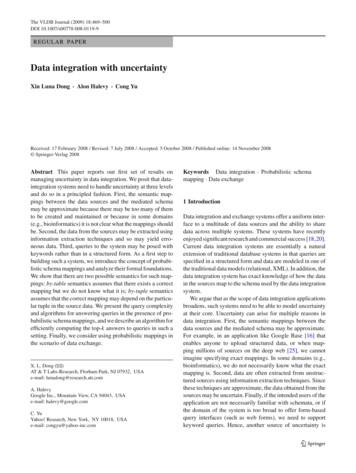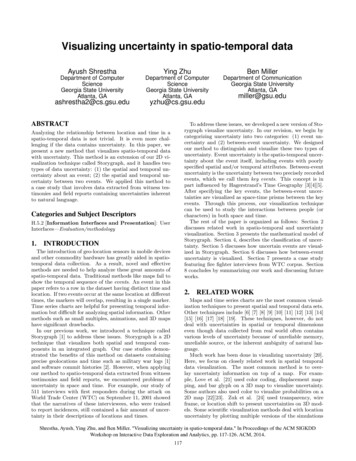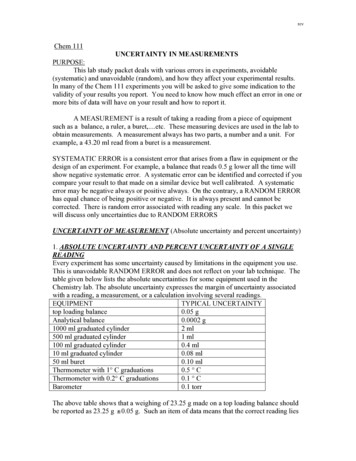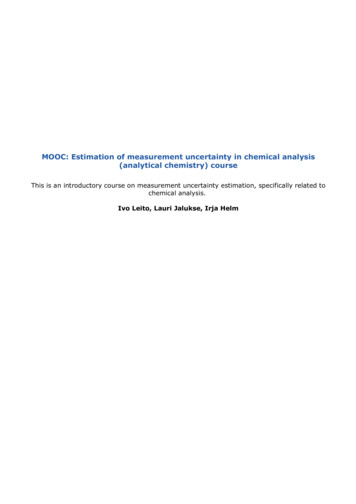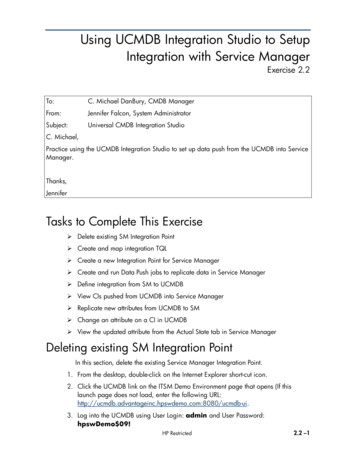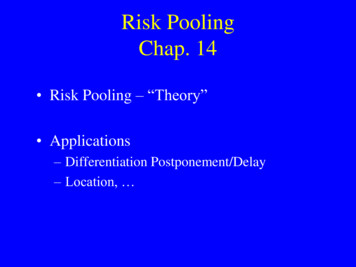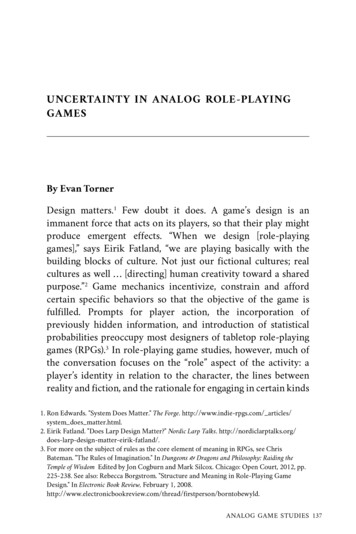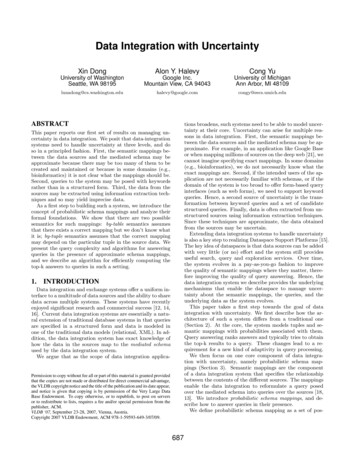
Transcription
Data Integration with UncertaintyXin DongAlon Y. HalevyCong YuUniversity of WashingtonSeattle, WA 98195Google Inc.Mountain View, CA 94043University of MichiganAnn Arbor, MI ngy@eecs.umich.eduABSTRACTtions broadens, such systems need to be able to model uncertainty at their core. Uncertainty can arise for multiple reasons in data integration. First, the semantic mappings between the data sources and the mediated schema may be approximate. For example, in an application like Google Baseor when mapping millions of sources on the deep web [21], wecannot imagine specifying exact mappings. In some domains(e.g., bioinformatics), we do not necessarily know what theexact mappings are. Second, if the intended users of the application are not necessarily familiar with schemas, or if thedomain of the system is too broad to offer form-based queryinterfaces (such as web forms), we need to support keywordqueries. Hence, a second source of uncertainty is the transformation between keyword queries and a set of candidatestructured queries. Finally, data is often extracted from unstructured sources using information extraction techniques.Since these techniques are approximate, the data obtainedfrom the sources may be uncertain.Extending data integration systems to handle uncertaintyis also a key step to realizing Dataspace Support Platforms [15].The key idea of dataspaces is that data sources can be addedwith very little (or no) effort and the system still providesuseful search, query and exploration services. Over time,the system evolves in a pay-as-you-go fashion to improvethe quality of semantic mappings where they matter, therefore improving the quality of query answering. Hence, thedata integration system we describe provides the underlyingmechanisms that enable the dataspace to manage uncertainty about the semantic mappings, the queries, and theunderlying data as the system evolves.This paper takes a first step towards the goal of dataintegration with uncertainty. We first describe how the architecture of such a system differs from a traditional one(Section 2). At the core, the system models tuples and semantic mappings with probabilities associated with them.Query answering ranks answers and typically tries to obtainthe top-k results to a query. These changes lead to a requirement for a new kind of adaptivity in query processing.We then focus on one core component of data integration with uncertainty, namely probabilistic schema mappings (Section 3). Semantic mappings are the componentof a data integration system that specifies the relationshipbetween the contents of the different sources. The mappingsenable the data integration to reformulate a query posedover the mediated schema into queries over the sources [18,13]. We introduce probabilistic schema mappings, and describe how to answer queries in their presence.We define probabilistic schema mapping as a set of pos-This paper reports our first set of results on managing uncertainty in data integration. We posit that data-integrationsystems need to handle uncertainty at three levels, and doso in a principled fashion. First, the semantic mappings between the data sources and the mediated schema may beapproximate because there may be too many of them to becreated and maintained or because in some domains (e.g.,bioinformatics) it is not clear what the mappings should be.Second, queries to the system may be posed with keywordsrather than in a structured form. Third, the data from thesources may be extracted using information extraction techniques and so may yield imprecise data.As a first step to building such a system, we introduce theconcept of probabilistic schema mappings and analyze theirformal foundations. We show that there are two possiblesemantics for such mappings: by-table semantics assumesthat there exists a correct mapping but we don’t know whatit is; by-tuple semantics assumes that the correct mappingmay depend on the particular tuple in the source data. Wepresent the query complexity and algorithms for answeringqueries in the presence of approximate schema mappings,and we describe an algorithm for efficiently computing thetop-k answers to queries in such a setting.1.INTRODUCTIONData integration and exchange systems offer a uniform interface to a multitude of data sources and the ability to sharedata across multiple systems. These systems have recentlyenjoyed significant research and commercial success [12, 14,16]. Current data integration systems are essentially a natural extension of traditional database systems in that queriesare specified in a structured form and data is modeled inone of the traditional data models (relational, XML). In addition, the data integration system has exact knowledge ofhow the data in the sources map to the mediated schemaused by the data integration system.We argue that as the scope of data integration applica-Permission to copy without fee all or part of this material is granted providedthat the copies are not made or distributed for direct commercial advantage,the VLDB copyright notice and the title of the publication and its date appear,and notice is given that copying is by permission of the Very Large DataBase Endowment. To copy otherwise, or to republish, to post on serversor to redistribute to lists, requires a fee and/or special permission from thepublisher, ACM.VLDB ‘07, September 23-28, 2007, Vienna, Austria.Copyright 2007 VLDB Endowment, ACM 978-1-59593-649-3/07/09.687
sible (ordinary) mappings between a source schema and atarget schema, where each possible mapping has an associated probability. We begin by considering a simple classof mappings, where each mapping describes a set of correspondences between the attributes of a source table and theattributes of a target table. We argue that there are twopossible interpretations of probabilistic schema mappings.In the first, called by-table semantics, we assume there existsa single correct mapping between the source and the target,but we don’t know which one it is. In the second, calledby-tuple semantics, the correct mapping may depend on theparticular tuple in the source to which it is applied. In bothcases, the semantics of query answers are a generalization ofcertain answers [1] for data integration systems.We describe algorithms for answering queries in the presence of probabilistic schema mappings and then analyze thecomputational complexity of answering queries (Section 4).We show that the data complexity of answering queries inthe presence of probabilistic mappings is PTIME for bytable semantics and #P-complete for by-tuple semantics.We identify a large subclass of real-world queries for whichwe can still obtain all the by-tuple answers in PTIME. Wethen describe algorithms for finding the top-k answers to aquery (Section 5).The size of a probabilistic mapping may be quite large,since it essentially enumerates a probability distribution bylisting every combination of events in the probability space.In practice, we can often encode the same probability distribution much more concisely. Our next contribution (Section 6) is to identify two concise representations of probabilistic mappings for which query answering can be done inPTIME in the size of the mapping. We also examine the possibility of representing a probabilistic mapping as a BayesNet, but show that query answering may still be exponentialin the size of a Bayes Net representation of a mapping.Finally, we consider several more powerful mapping languages, such as complex mappings, where the correspondences are between sets of attributes, and conditional mappings, where the mapping is conditioned on properties of thetuple to which it is applied (Section 7).2.QKeywordReformulationMediated SchemaQ 1,.Q mQueryReformulationQ 11,.Q 1n, ,Qk1,.Q knQueryPocessorQ 11,.Q 1n.Q k1,.Q knDkD1D4D2D3Figure 1: Architecture of a data-integration system thathandles uncertainty.schema mappings are often generated by semi-automatictools, and not necessarily verified by domain experts.Uncertain data: By nature, data integration systems needto handle uncertain data. One reason for uncertainty is thatdata is often extracted from unstructured or semi-structuredsources by automatic methods (e.g., HTML pages, emails,blogs). A second reason is that data may come from sourcesthat are unreliable or not up to date.Uncertain queries: In some data integration applications,especially on the web, queries will be posed as keywordsrather than as structured queries against a well defined schema.The system needs to translate these queries into some structured form so they can be reformulated with respect to thedata sources. At this step, the system may generate multiple candidate structured queries and have some uncertaintyabout which is the real intent of the user.2.2 System ArchitectureGiven the above requirements, we describe the architecture of a data integration system that manages uncertaintyat its core. We describe the system by contrasting it to atraditional data integration system.The first and most fundamental characteristic of this system is that it is based on a probabilistic data model. Thismeans two things. First, as we process data in the systemwe attach probabilities to each tuple. Second, and the focusof this paper, is that schema mappings are also associatedwith probabilities, modeling our uncertainty about whichones are correct. We note that the probabilities associatedwith tuples, mappings, and answers are mostly internal tothe system, and are not meant to be exposed to users. Typically, we will use these probabilities to rank answers.Second, whereas traditional data integration systems begin by reformulating a query onto the schemas of the datasources, a data integration system with uncertainty needsto first reformulate a keyword query into a set of candidatestructured queries. We refer to this step as keyword reformulation. Note that keyword reformulation is different fromtechniques for keyword search on structured data (e.g., [17,2]) in that (a) it does not assume access to all the data inthe sources or that the sources support keyword search, and(b) it tries to distinguish different structural elements in thequery in order to pose more precise queries to the sources(e.g., realizing that in the keyword query “chicago weather”,“weather” is an attribute label and “chicago” is an instanceOVERVIEW OF THE SYSTEMThis section describes the requirements from a data integration system that supports uncertainty and the overallarchitecture of the system. We frame our specific contributions in context of this architecture.2.1 Uncertainty in Data IntegrationA data integration system needs to handle uncertainty atthree levels.Uncertain schema mappings: Data integration systemsrely on schema mappings for specifying the semantic relationships between the data in the sources and the terms usedin the mediated schema. However, schema mappings can beinaccurate. In many applications it is impossible to createand maintain precise mappings between data sources. Thiscan be because the users are not skilled enough to provideprecise mappings, such as in personal information management [7], because people do not understand the domain welland thus do not even know what correct mappings are, suchas in bioinformatics, or because the scale of the data prevents generating and maintaining precise mappings, such asin integrating data of the web scale [21]. Hence, in practice,688
name). That being said, keyword reformulation should benefit from techniques that support answering keyword searchon structured data.Third, the query answering model is different. Instead ofnecessarily finding all answers to a given query, our goal istypically to find the top-k answers, and rank these answersmost effectively.The final difference from traditional data integration systems is that our query processing will need to be more adaptive than usual. Instead of generating a query answeringplan and executing it, the steps we take in query processing will depend on results of previous steps. We note thatadaptive query processing has been discussed quite a bit indata integration [19], where the need for adaptivity arisesfrom the fact that data sources did not answer as quickly asexpected or that we did not have accurate statistics abouttheir contents to properly order our operations. In our work,however, the goal for adaptivity is to get the answers withhigh probabilities faster.The architecture of the system is shown in Figure 1. Thesystem contains a number of data sources and a mediatedschema. When the user poses a query Q, which can be eithera structured query on the mediated schema, or a keywordquery, the system returns a set of answer tuples, each witha probability. If Q is a keyword query, the system firstperforms keyword reformulation to translate it into a setof candidate structured queries on the mediated schema.Otherwise, the candidate query is Q itself.Consider how the system answers the candidate queries,and assume the queries will not involve joins over multiple sources. For each candidate structured query Q0 anda data source S, the system reformulates Q0 according tothe schema mapping (which can be uncertain) between S’sschema and the mediated schema, sends the reformulatedquery (or queries) to S, retrieving the answers. If the userasks for all the answers to the query, then the reformulatedquery is typically a query with grouping and aggregation. IfS does not support grouping and aggregation, then groupingand aggregation can be processed in the integration system.If the user asks for top-k answers, then query processing ismore complex. The system reformulates the query into aset of queries, and uses a middle layer to decide at runtimewhich queries are critical to computing the top-k answersand sends the appropriate queries to S. Note that therecan be multiple iterations of deciding the promising reformulated queries and retrieving answers. Furthermore, thesystem can even decide which data sources are more relevantand prioritize the queries to those data sources. Finally, ifthe data in the sources are uncertain, then the sources willreturn answers with probabilities attached to them.After receiving answers from different data sources, thesystem combines them to get one single set of answer tuples. For example, if the data sources are known to beindependent of each other, and we obtain tuple t from ndata sources with probabilities p1 , . . . , pn respectively, thenin the final answer set t has probability 1 Πni 1 (1 pi ). Ifwe know that some data sources are duplicates or extensionsof others, a different combination function needs to be used.Possible MappingProb{(pname, name), (email-addr, email),m1 (current-addr, mailing-addr),0.5(permanent-addr, home-address)}{(pname, name), (email-addr, email),m2 (permanent-addr, mailing-addr),0.4(current-addr, home-address)}m3 {(pname, name), (email-addr, mailing-addr),0.1(current-addr, home-addr)}(a)pname email-addr permanent-addr current-addrDS Alicealice@Mountain (’Sunnyvale’)0.9(’Mountain re 2: The running example: (a) a probabilisticschema mapping between S and T ; (b) a source instance DS ; (c) the answers of Q over DS with respectto the probabilistic mapping.ence. Before the formal discussion, we illustrate the mainideas with an example.Example 2.1. Consider a data source S, which describesa person by her email address, current address, and permanent address, and the mediated schema T , which describes aperson by her name, email, mailing address, home addressand office address:S (pname, email-addr, current-addr, permanent-addr)T (name, email, mailing-addr, home-addr, office-addr)A semi-automatic schema-mapping tool may generate threepossible mappings between S and T , assigning each a probability. Whereas the three mappings all map pname to name,they map other attributes in the source and the target differently. Figure 2(a) describes the three mappings using sets ofattribute correspondences. For example, mapping m1 mapspname to name, email-addr to email, current-addr to mailingaddr, and permanent-addr to home-addr. Because of the uncertainty on which mapping is correct, we consider all ofthese mappings in query answering.Suppose the system receives a query Q composed on themediated schema and asking for people’s mailing addresses:Q: SELECT mailing-addr FROM TUsing the possible mappings, we can reformulate Q intodifferent queries:Q1: SELECT current-addr FROM SQ2: SELECT permanent-addr FROM SQ3: SELECT email-addr FROM SIf the user requires all possible answers, the system generates a single aggregation query based on Q1 , Q2 and Q3 tocompute the probability of each returned tuple, and sends thequery to the data source. Suppose the data source containsa table DS as shown in Figure 2(b), the system will retrievefour answer tuples, each with a probability, as shown in Figure 2(c).2.3 Handling Uncertainty in MappingsAs a first step towards developing such a data integration system, we introduce in this paper probabilistic schemamappings, and show how to answer queries in their pres-689
If the user requires only the top-1 answer (i.e., the answer tuple with the highest probability), the system decidesat runtime which reformulated queries to execute. For example, after executing Q1 and Q2 at the source, the systemcan already conclude that (‘Sunnyvale’) is the top-1 answerand can skip query Q3 .2permanent-addr current-addrMountain ViewSunnyvaleSunnyvaleSunnyvale(a)name emailmailing-addrhome-addr office-addrAlice alice@ Mountain View ame email mailing-addrhome-addroffice-addrAlice alice@SunnyvaleMountain .50.5(’Mountain View’)(’Mountain ��bob@’)(’bob@’)(d)(e)DS 2.4 Source of probabilitiesA critical issue in any system that manages uncertainty iswhether we have a reliable source of probabilities. Whereasobtaining reliable probabilities for such a system is one ofthe most interesting areas for future research, there is quitea bit to build on. For keyword reformulation, it is possibleto train and test reformulators on large numbers of queriessuch that each reformulation result is given a probabilitybased on its performance statistics. In the case of schemamatching, it is standard practice for schema matchers to alsoassociate numbers with the candidates they propose. Theissue here is that the numbers are meant only as a ranking mechanism rather than true probabilities. However, asschema matching techniques start looking a larger numberof schemas, one can imagine ascribing probabilities (or approximations thereof) to their measures. Finally, information extraction techniques are also often based on statisticalmachine learning methods, thereby lending their predictionsa probabilistic Figure 3: Example 3.10: (a) a source instance DS ;(b) a target instance that is by-table consistent withDS ; (c) a target instance that is by-tuple consistentwith DS ; (d) Qtable (DS ); (e) Qtuple (DS ).most once on each side of the mapping. We consider thisclass of mappings because they already expose many of thenovel issues involved in probabilistic mappings and becausethey are quite common in practice. We also note that manyof the concepts we define apply to a broader class of mappings. In Section 7, we briefly discuss a set of extensions toour mappings, such as complex mappings.Given these restrictions, we can define our mappings interms of attribute correspondences. An attribute correspondence is of the form cij (si , tj ), where si is a source attribute in the schema S and tj is a target attribute in theschema T . Intuitively, cij specifies that there is a relationship between si and tj . In practice, a correspondencealso involves a function that transforms the value of si tothe value of tj . For example, the correspondence (c-degree,temperature) can be specified as temperature c-degree 1.8 32, describing a transformation from Celsius to Fahrenheit.These functions are irrelevant to our discussion, and therefore we omit them. Formally, we define relation mappingsand schema mappings as follows.PROBABILISTIC SCHEMA MAPPINGIn this section we formally define the semantics of probabilistic schema mappings and the query answering problemswe consider. Our discussion is in the context of the relational data model. A schema contains a finite set of relations. Each relation contains a finite set of attributes andis denoted by R hr1 , . . . , rn i. An instance DR of R is afinite set of tuples, where each tuple associates a value witheach attribute in the schema.We consider select-project-join (SPJ) queries in SQL. Notethat answering such queries is in PTIME in the size of thedata.3.1 Schema MappingsWe begin by reviewing non-probabilistic schema mappings.The goal of a schema mapping is to specify the semantic relationships between a source schema and a target schema.We refer to the source schema as S̄, and a relation in S̄ asS hs1 , . . . , sm i. Similarly, we refer to the target schemaas T̄ , and a relation in T̄ as T ht1 , . . . , tn i.The common formalism for semantic mappings, GLAV, isbased on expressions of the formDefinition 3.1 (Schema Mapping). Let S̄ and T̄ berelational schemas. A relation mapping M is a triple (S, T, m),where S is a relation in S̄, T is a relation in T̄ , and m is aset of attribute correspondences between S and T .When each source and target attribute occurs in at mostone correspondence in m, we call M a one-to-one relationmapping.A schema mapping M is a set of one-to-one relation mappings between relations in S̄ and in T̄ , where every relationin either S̄ or T̄ appears at most once.2m : x(φ(x) yψ(x, y))In the expression, φ is the body of a conjunctive query overS̄ and ψ is the body of a conjunctive query over T̄ . A pairof instances DS and DT satisfies a GLAV mapping m, if forevery assignment of x in DS that satisfies φ there exists anassignment of y in DT that satisfies ψ.We consider a limited form of GLAV mappings that involve only projection queries on a single table on each sideof the mapping. These mappings have also been referredto as schema matching in the literature [23]. Specifically,we consider GLAV mappings where (1) φ (resp. ψ) is anatomic formula over S (resp. T ), (2) the GLAV mappingdoes not include constants, and (3) each variable occurs atExample 3.2. Consider the mappings in Example 2.1.We can view m1 as a GLAV mapping: n, e, c, p(S(n, e, c, p) o(T (n, e, c, p, o)))The database in Figure 2 (b) (repeated in Figure 3 (a)) andthe database in Figure 3 (b) satisfy m1 .2690
3.2 Probabilistic Schema Mappingsall such target instances. The set of answers to a query Q isthe intersection of the answers on all instances in Tar M (DS ).The following definition is from [1].Intuitively, a probabilistic schema mapping describes aprobability distribution of a set of possible schema mappingsbetween a source schema and a target schema.Definition 3.3 (Probabilistic Mapping). Let S̄ andT̄ be relational schemas. A probabilistic mapping (p-mapping),pM , is a triple (S, T, m), where S S̄, T T̄ , and m is aset {(m1 , Pr (m1 )), . . . , (ml , Pr (ml ))}, such that for i [1, l], mi is a one-to-one mapping between Sand T , and for every i, j [1, l], i 6 j mi 6 mj .P Pr (mi ) [0, 1] and li 1 Pr (mi ) 1.Definition 3.5 (Certain Answer). Let M (S, T, m)be a relation mapping. Let Q be a query over T and let DSbe an instance of S.A tuple t is said to be a certain answer of Q with respectto DS and M , if for every instance DT Tar M (DS ), t Q(DT ).2By-table semantics: We now generalize these notions tothe probabilistic setting, beginning with the by-table semantics.A schema p-mapping, pM, is a set of p-mappings betweenrelations in S̄ and in T̄ , where every relation in either S̄ orT̄ appears in at most one p-mapping.2Definition 3.6 (By-table Consistent Instance). LetpM (S, T, m) be a p-mapping and DS be an instance ofS.An instance DT of T is said to be by-table consistent withDS and pM , if there exists a mapping m m such that DSand DT satisfy m.2We refer to a non-probabilistic mapping as an ordinarymapping. Note that a schema p-mapping may contain bothp-mappings and ordinary mappings. Example 2.1 shows a pmapping (see Figure 2(a)) that contains three possible mappings.Given a source instance DS and a possible mapping m m, there can be an infinite number of target instances thatare consistent with DS and m. We denote by Tar m (DS ) theset of all such instances.In the probabilistic context, we assign a probability toevery answer. Intuitively, we consider the certain answerswith respect to each possible mapping in isolation. Theprobability of an answer t is the sum of the probabilities ofthe mappings for which t is deemed as a certain answer. Wedefine by-table answers as follows:3.3 Semantics of Probabilistic MappingsIntuitively, a probabilistic schema mapping models theuncertainty about which of the mappings in pM is the correct one. When a schema matching system produces a setof candidate matches, there are two ways to interpret theuncertainty: (1) a single mapping in pM is the correct oneand it applies to all the data in S, or (2) multiple mappingsare correct and each suitable for a subset of tuples in S,though it is unknown which mapping is the right one fora specific tuple. Example 2.1 illustrates the first interpretation. For the same example, the second interpretation isequally valid: the correct mapping may depend on the particular tuple because some people use their current addressas mailing address and some people use their permanentaddress as mailing address.This paper analyzes query answering under both interpretations. We refer to the first interpretation as the by-tablesemantics and to the second one as the by-tuple semanticsof probabilistic mappings. We note that we are not tryingto argue for one interpretation over the other. The needsof the application should dictate the appropriate semantics.Furthermore, our complexity results, which will show advantages to by-table semantics, should not be taken as anargument in the favor of by-table semantics.We next define the semantics of p-mappings in detail; thedefinitions for schema p-mappings are the obvious extensions. The semantics of p-mappings is defined as a naturalextension of that of ordinary ones, which we review now. Amapping defines a relationship between instances of S andinstances of T that are consistent with the mapping.Definition 3.7 (By-table Answer). Let pM (S, T,m) be a p-mapping. Let Q be a query over T and let DS bean instance of S.Let t be a tuple. Let m̄(t) be the subset of m, such that foreach m m̄(t)P and for each DT Tar m (DS ), t Q(DT ).Let p m m̄(t) Pr (m). If p 0, then we say (t, p) is aby-table answer of Q with respect to DS and pM .2By-tuple semantics: The key difference in the definitionof by-tuple semantics is that a consistent target instance isdefined by a mapping sequence that assigns a (possibly different) mapping in m to each tuple in DS . (Without losinggenerality, in order to compare between such sequences, weassign some order to the tuples in the instance).Definition 3.8 (By-tuple Consistent Instance). LetpM (S, T, m) be a p-mapping and let DS be an instanceof S with d tuples.An instance DT of T is said to be by-tuple consistent withDS and pM , if there is a sequence hm1 , . . . , md i such thatfor every 1 i d,Definition 3.4 (Consistent Target Instance). LetM (S, T, m) be a relation mapping and DS be an instanceof S.An instance DT of T is said to be consistent with DS andM , if DS and DT satisfy m.2For a relation mapping M and a source instance DS , therecan be an infinite number of target instances that are consistent with DS and M . We denote by Tar M (DS ) the set of691 mi m, and for the ith tuple of DS , ti , there exists a target tuplet′i DT such that ti and t′i satisfy mi .2Given a mapping sequence seq hm1 , . . . , md i, we denoteby Tar seq (DS ) the set of all target instances that are consistent with DS and seq . Note that if DT is by-table consistentwith DS and m, then DT is also by-tuple consistent with DSand a mapping sequence in which each mapping is m.
We can think of every sequence of mappings seq hm1 , . . . ,md i as a separate event whose probability is Pr (seq ) Πdi 1 Pr (mi ). (In Section 7 we relax this independence assumption and introduce conditional mappings.) If there arel mappings in pM , then there are ld sequences of length d,and their probabilities add up to 1. We denote by seqd (pM )the set of mapping sequences of length d generated from pM .Definition 3.9 (By-tuple Answer). Let pM (S, T,m) be a p-mapping. Let Q be a query over T and DS be aninstance of S with d tuples.Let t be a tuple. Let seq (t) be the subset of seqd (pM ), suchthat for each seq seq (t) and for each DT Tar seq (DS ),t Q(DT ). PLet p seq seq(t) Pr (seq ). If p 0, we call (t, p) aby-tuple answer of Q with respect to DS and pM .2The set of by-table (resp. by-tuple) answers for Q withrespect to DS is denoted by Qtable (DS ) (resp. Qtuple (DS )).Example 3.10. Consider the p-mapping pM , the sourceinstance DS , and the query Q in the motivating example.In by-table semantics, Figure 3(b) shows a target instancethat is consistent with DS (repeated in Figure 3(a)) and possible mapping m1 . Figure 3(d) shows the by-table answersof Q with respect to DS and pM . As an example, for tuplet (‘Sunnyvale’), we have m̄(t) {m1 , m2 }, so the possibletuple (‘Sunnyvale’, 0.9) is an answer.In by-tuple semantics, Figure 3(c) shows a target instancethat is by-tuple consistent with DS and the m
certainty in data integration. We posit that data-integration systems need to handle uncertainty at three levels, and do so in a principled fashion. First, the semantic mappings be-tween the data sources and the mediated schema may be approximate because there may be too many of them to be created and maintained or because in some domains (e.g.,
